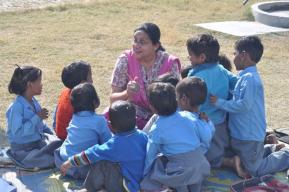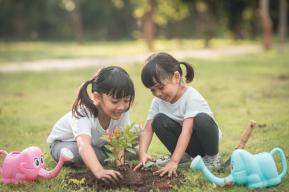Idea
Bamboo houses mitigate the effects of climate change in Pakistan

Zofeen T. Ebrahim
Pakistani journalist
“No more leaky roofs for me,” remarks 22-year-old Devi when asked what she liked best about her new house. Like most of the inhabitants of the village of Akhund Jo Khoo situated in Sindh province, some 200 kilometres from the port city of Karachi, Devi lost everything in 2022 in the torrential rains that swept through the region.
Having lived under a tattered tent with her two sons, aged seven and eight, for almost a year, she recently moved into a new chaunra, a traditional one-roomed house of this desert region. She is not alone. Sadqa Pakistan, a Pakistani social enterprise has built more than 70 homes in her village.
Pakistan witnessed its most devastating monsoons between June and September 2022, resulting in floods that submerged a third of the country and affected 33 million people. The Post-Disaster Needs Assessment (PDNA) carried out by the government estimated the total damage at US$14.9 billion, and economic losses at about US$15.2 billion.
In the hardest-hit province of Sindh, home to 50 million residents, up to two million houses were damaged, 75 per cent of which were mud houses.
Flood-resistant houses
Like her old home, the new chaunra Devi is living in is also made of mud and bamboo. But the new house is much more resistant than the old one. Yasmeen Lari, the world-famous architect behind these houses, has combined indigenous knowledge with science and engineering to make them flood-proof.
The elevated structure of the houses prevents water from penetrating inside in the event of flooding. The bamboos used are cured to make them termite-proof and the earth used for the walls is strengthened by adding lime and rice husk. The roof made of bamboo and covered with reed matting, finished with layers of thatch allows movement of air and keeps the interior cool. The steep conical roof keeps the interior protected from rainwater ingress.
Lari has also developed a mud- and lime-plaster stove that counters the negative health and environmental effects of cooking with open fires. Her eco-alternative is fueled by agricultural waste like cow dung or sawdust bricks, substantially reducing firewood consumption.
These houses will not collapse, not by wind, rain or quake
“These will not collapse, not by wind, rain or quake,” says the octogenarian architect. Her organization, the Heritage Foundation of Pakistan, has been working on humanitarian architecture, building disaster-resilient homes to mitigate the effects of climate change for two decades now. It has built up to 10,000 homes since 2022.
Zero-waste village
These homes are also easy to repair and replace. Their materials can be easily transported and reused if a household decides to move. “Most importantly, Yasmeen Lari is involving the rural communities in the process so there is a sense of ownership,” says Hira Zuberi, a Karachi-based independent architect.
But building homes for the poor is not enough to take them out of the vortex of poverty. “There is a huge potential among the people living on the margins. When they get trained, they become economically empowered,” Lari stresses. Her aim is to reduce dependence on charity and dole-outs.
Transmitting knowledge to local populations helps reduce their dependence on charity and dole-outs
Beyond providing decent housing for disaster victims, Lari aims to create a virtuous circle. One example is the zero-waste system she has developed in Pono, a village in Sindh’s district of Tando Allah Yar. The villagers have built energy-efficient mud stoves, a shared toilet between two families, a solar panel between twelve households and a hand pump between eight families, all built within a budget of 43,000 Pakistani Rupees (US$150.85). “They have started growing their own vegetables. They are keeping chickens. The waste from the toilet is turned into compost.”
A thousand new homes
“We wanted to provide shelter for the homeless villagers, so we started looking up low-cost housing designs. Lari’s was not only the cheapest, it was also the nicest,” Dr Asad Ali, the founder of Sadqa Pakistan, says. A pediatrician and infectious disease specialist at the Aga Khan University Hospital in Karachi, he has been working on solving chronic malnutrition among rural communities in Matiari.
So far, 550 homes have been built in nearly 35 villages by the enterprise, with another 60 to be built by the end of 2023. Sadqa Pakistan also provides a washroom to be shared between three households and energy-efficient stoves modeled after Lari’s.
Although the project is funded by donations, the residents participate in the process. Devi provided the workers with earth from within the village for them to mix the plaster. With that plaster she coated the walls made of straw matting. “Once the structure is put up, the homeowners help plaster the exterior and interior walls,” explains Dr Umrani, a volunteer.
Local training
Training plays a key role in such projects. Sadqa Pakistan is following Lari’s pattern of imparting knowledge through a local training initiative. Jaman Rai, an 18-year-old student, was among the six men who went to Thatta to get a five-day, hands-on training at Lari’s Heritage Foundation of Pakistan’s training centre at Makli. After their return, they set up their own training centre in the village of Bhoriyoon. “A domino effect has started,” says Rai. “We have trained nearly five dozen men and several of them have set up their own practice.”
Rai, now a master trainer himself, makes a decent living of 30,000 Rupees (US$105) per month. The first house he built after the training was his own, to replace the one that had washed away in the floods. Having now built nearly 60, Rai firmly believes these will stay put in the strongest of gusts and in the most ferocious of rains.
Yasmeen Lari: “Starchitect” turned humanitarian
The first female architect of Pakistan, Yasmeen Lari is an architectural historian and humanitarian architect. Born in 1941, she graduated from Oxford Brookes University (United Kingdom). Her architectural firm designed some of the most iconic projects in Pakistan during the second half of the 20th century. Today she is best known for her involvement in the intersection of architecture and social justice.
In 2023 Lari received the Gold Medal of the Royal Institute of British Architects (RIBA). The prestigious award is given in recognition of a lifetime’s work to a person or group of people who have had a significant influence on the advancement of architecture.
Yasmeen Lari is also involved in heritage conservation, notably as a UNESCO consultant. She has for example conserved structures at Makli and the Lahore Fort, two Pakistani sites inscribed on the World Heritage list.








